Kathleen Flinn's Blog, page 8
November 27, 2021
No Stress Guide to Hosting Holiday Dinner
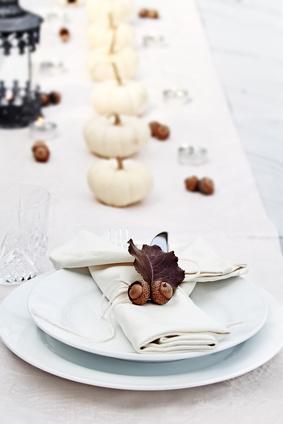 Table tip: Go white, and then add color (or not) with collected leaves, small squash, acorns and natural elements for an inexpensive, yet elegant effect.
Table tip: Go white, and then add color (or not) with collected leaves, small squash, acorns and natural elements for an inexpensive, yet elegant effect.
Hosting a holiday dinner can feel overwhelming. This is especially true if you’re a novice cook, or frankly, if you haven’t had a gathering of more than your pod since the start of the pandemic. All that food, the dishes, the cleaning, the table decor… where to start? I’m here to help. Start with a deep breath.
Remember the math. Most classic holiday dinner menus include a main dish, gravy or sauce, potatoes, two to three vegetables, some bread, plus dessert. Figuring out what to serve is Step 1 in hosting a holiday dinner.
But then Step 2 is figuring out whom to help you. Ham is a popular option at Christmas and Easter. To make things easy on yourself, get one that’s already cooked or smoked, so you just have to slightly reheat and serve.
If you’re opting for a roast turkey – a favorite for both Thanksgiving and Christmas in the U.S. and Christmas in other countries – then you can focus on the turkey, gravy and stuffing and then delegate all the side dishes and at least a couple of pies (or buy them), you’ve wildly cut down on the tasks at hand. This is the same advice that Rick Rodgers, the author of Christmas 101, offers novice cooks in his excellent primer for novice cooks on Epicurious.
Food writer Jess Thomson has this advice: “I try to reduce the number of dishes I feel have to be piping hot. I think there’s a huge misconception that all the food has to be ready at exactly the same time.” With that in mind, she includes dishes that are more flexible – roasted carrots, for instance – and dishes that are better after they sit for 15 to 20 minutes, such as a potato gratin.
Get 37 Awesome Hosting Tips from Pro Food WritersCheck out this awesome infographic on the subject from SavvyEats.How to Create a MenuAs soon as you know you’ll be hosting a holiday dinner, you’ll want to do two things. Create a guest list to get an idea of how many you’ll be hosting. Second, start thinking of the menu. When I am hosting any kind of party, I start by making a table, like the one below. It can just be a rough sketch on a legal pad or sheet of paper. Your goal is to buy or assign at least half the items.
Holiday Dinner, 12 guests, Christmas
CourseRecipeMake/buy AssignedNotesMain dishHoney-Baked HamBuyPick up on Dec. 22StarchMashed potatoesMakeMake day early, reheatVegRoasted Brussels sproutsSandyVegRoasted carrotsMakeMake early, reheatVegGreen beansMakeSteamedBreadDinner rollsBuy12 rollsDessertPies – threeSandyGet from bakery Main Course
Main CourseHere are my go-to recipes for classic main courses.
Roast Beef : Impressive, yet uncomplicated. Braised Lamb Shanks : Great comfort food. After initial browning, shanks cook themselves. Old-fashioned turkey with gravy : It’s hard to beat Rodgers’ detailed step-by-step guide. Spend an extra $10 or so and buy a fresh kosher bird, which is salted and rinsed as part of the kosher process so it requires no brine. Ham : Easily feeds a crowd, most come pre-cooked, and honestly, you can buy one from the likes of Honey Baked Ham. Vegetarian : I served Kim O’Donnel’s terrific Shepard’s Pie a couple of times. I made two – one with meat, one with the wine braised-lentils and chard called for in her version. Everyone preferred the vegetarian option. So, there you go. I’ve also served this vegetarian wellington from omgyummy. Stuffing/Dressing
Stuffing/DressingThe good news is that all the prep for stuffing can be done a couple of days ahead and tossed into a baking dish – just don’t add the liquid or eggs until just before you’re ready to bake it along. This year, I’m once again making this fabulous stuffing with apples, bacon and caramelized onions by Diane Morgan. Want something else? I’m a big fan of this interactive build-your-own-stuffing guide from Fine Cooking. One of my tricks: baste the stuffing with a bit of the turkey juices toward the end of cooking.
 Potatoes
PotatoesFor mashed potatoes, you can prep them in the afternoon and then keep them warm by putting into a bowl covered with plastic wrap and settling it into a simmering bath on the back of the stove. My friend Chef John has a great video on making mashed potatoes, although I prefer Yukon Gold potatoes over russets, but it’s a minor point. Don’t have a potato masher? Fear not. You can always use a large fork.
 My husband is partial to scalloped potatoes, and I’ve become a fan of them for big meals because once baked, they can hang out lightly covered for a half hour or so until everything’s ready. I’ve tried a dozen recipes, and my favorite by a long shot is Thomson’s potato gratin with chevre and pancetta.
My husband is partial to scalloped potatoes, and I’ve become a fan of them for big meals because once baked, they can hang out lightly covered for a half hour or so until everything’s ready. I’ve tried a dozen recipes, and my favorite by a long shot is Thomson’s potato gratin with chevre and pancetta.
 Side dishes
Side dishesDon’t go too crazy. With stuffing and potatoes, three vegetable side dishes are enough for groups up to about 12. After that, add another side dish for each additional three people. Don’t forget colors, and go with a variety: green beans, carrots, corn, etc. Here’s what I am making for my side dishes this year: Roasted carrots with mustard, glazed brussel sprouts and apples in brown butter and cream and roasted cauliflower with gremolata bread crumbs. Some other great sides: SpoonandSaucer’s How to Make Cranberry Sauce (with video!) and Northwest Rice Pilaf, TheSpicedLife’s Cream of Wild Mushroom Soup and Food Goes Healthy’s Shaved Brussels Sprouts Salad with Dates
Here are three troves of reliable side dish recipes: The New York Times, Food52 and Southern Living.
 Something sweet
Something sweetCranberries are a die-hard staple, and ever-so-good on leftover sandwiches. Making a dish from scratch isn’t much more difficult than opening the can and slicing them. Here’s my family recipe for cranberries with port and ginger.
 Breads
BreadsIf you’re not a baker, find a good bakery near you. I’ve become partial to a more flavorful bread, though. Last year, I made this terrific rosemary focaccia by Elise Bauer at Simply Recipes.
 Dessert
DessertPie is traditional, obviously, but it doesn’t mean you have to slave making a huge coterie of them. If you’re hosting dinner, ask other diners to bring pie and ice cream. Or, order some pies from a local bakery. If you want to try something with a twist, try my recipe for Light Pumpkin Cheesecake. Also, don’t overlook cheese as an option for dessert. “It seems like people forget the option for Thanksgiving,” says Judith Finlayson, the author of a dozen cookbooks, most recently 750 Best Appetizers. “My husband goes crazy on buying cheeses for a final course…served with port.”
 Beverages & the Holiday Pantry
Beverages & the Holiday PantryBe sure to stock up on wine, non-alcoholic beverages and the like as part of your shopping. Not enough food writers focus on pantries. Here’s a good take on a holiday pantry from MyRecipes.com. I’m also a fan of this cranberry cocktail recipe from CreativeCulinary and this slow cooker apple Chai from FarmFreshFeasts.
To sum upHosting a holiday dinner is inevitably a lot of work. But these festive tables are often home to many great memories. Pour yourself a favorite beverage, start with a chart, check out these tips and don’t worry. It will all be fine.
The post No Stress Guide to Hosting Holiday Dinner appeared first on Kathleen Flinn.
November 12, 2021
Real Mashed Potatoes vs. Instant
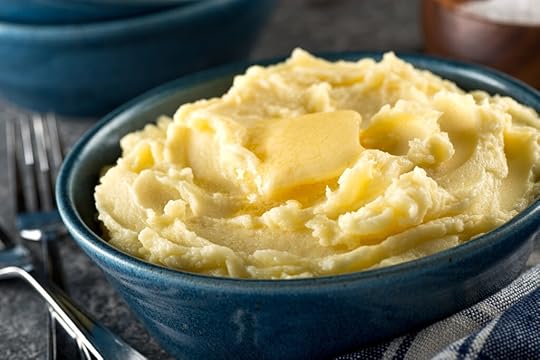
The next round of my Thanksgiving Dinner Firehouse Challenge put real mashed potatoes vs. instant mashed potatoes. I understand the lure of instant mashed potatoes. You want comfort and you want it now. I love them so much that if food could be your spirit animal, mine would be mashed potatoes.
According to Wisegeek.com, a Canadian scientist developed instant mashed back in 1962. Nutritionally speaking, instant mashed potatoes offer roughly the same vitamins and minerals as the real mashed potatoes with the exception of Vitamin C.
To please palates, they tend to be higher in sodium, significantly higher than the amount of salt home cooks would add when making them at home from scratch. Like most brands, the instant mashed potatoes I used were based on Idaho potatoes. Here’s how the real thing stacked up to the packaged variety in our challenge.
In this challenge, I used my own recipe for Perfect Mashed Potatoes, based on the recipe I learned at Le Cordon Bleu in Paris. The key to that recipe is using a food mill (one of my favorite kitchen gadgets), although you can certainly use a masher.
The lowdown on homemade mashed potatoes At $3.99 for a five pound bag of Yukon Gold potatoes and 75 cents in butter and milk, homemade wins in the cost department. The standard serving size for mashed potatoes used by caterers is about 2/3 cup mashed potatoes per person.
At $3.99 for a five pound bag of Yukon Gold potatoes and 75 cents in butter and milk, homemade wins in the cost department. The standard serving size for mashed potatoes used by caterers is about 2/3 cup mashed potatoes per person.
However, packages for instant mashed potato list 1/2 cup as a serving, so I used that as a standard although one of my brothers would look at me as if I was punishing him if I served up only half a cup.
A pound of potatoes yields about two cups mashed or four servings. So, five pounds of potatoes yields 20 servings. Although they are not challenging, homemade mashed potatoes do take time. There’s peeling and mashing, plus you need a large pot, a strainer and at least a fork.
Process: Peel the potatoes, boil, mash with butter, milk, salt and pepper. (See my full recipe on making perfect mashed potatoes the French way.)
Active time: 18 minutes (peeling, mashing)
Total time: 38 minutes
Cost per serving: 23 cents
Ingredients: POTATOES, BUTTER, MILK, SALT, PEPPER
 In the bag, you get four ounces of powdered mashed potatoes flakes imbued with the other stuff listed below. The Idahoan package reads “with Buttery Homestyle flavored mashed potatoes, you’ll enjoy the superior taste of Idaho potatoes blended perfectly with real butter. They’re satisfyingly rich. They’re delightfully creamy. And the genuine buttery flavor is 100% irresistible.”
In the bag, you get four ounces of powdered mashed potatoes flakes imbued with the other stuff listed below. The Idahoan package reads “with Buttery Homestyle flavored mashed potatoes, you’ll enjoy the superior taste of Idaho potatoes blended perfectly with real butter. They’re satisfyingly rich. They’re delightfully creamy. And the genuine buttery flavor is 100% irresistible.”
However, there is no actual butter listed in the ingredients, only a “butter powder” that includes sweet cream, salt and annatto coloring. But since butter is made from cream originally, this may be viewed as splitting hairs. An issue here is about the reliability of the serving size quoted. In the supermarket, I asked a woman buying this product how many servings a packet usually yields and she said two. “My husband and I usually split one.” She was buying six packets for Thanksgiving to feed seven guests. Each 1/2 cup serving contained a hearty 19% of daily sodium intake, so if you’re actually eating two servings, that 40% of your daily sodium in one cup of food. It is worth that after potatoes, the second ingredient is partially hydrogenated oil, a common additive used to extend shelf life that has can lead to elevated LDL cholesterol levels. (That’s the bad cholesterol.)
Process: Add pouch contents to boiling water. Remove from heat, let stand one minute. Fluff with fork.
Active time: 2 minutes
Total time: 4 minutes
Total Cost: $1.39 per packet
Cost per serving: 35 cents
Ingredients: IDAHO® POTATO SLICES (PRESERVED WITH SODIUM BISULFITE), PARTIALLY HYDROGENATED OIL* (CONTAINS ONE OR MORE OF THE FOLLOWING: SOYBEAN, COTTONSEED, SUNFLOWER), CORN SYRUP SOLIDS, SALT, MALTODEXTRIN, COCONUT OIL, NONFAT DRY MILK, SUGAR, WHEY POWDER, SODIUM CASEINATE, BUTTER POWDER (BUTTER: SWEET CREAM, SALT ANNATTO COLOR), NONFAT MILK SOLIDS, SODIUM CASEINATE AND DISODIUM PHOSPHATE, MONO & DIGLYCERIDES, CALCIUM STREARYL LACTYLATE, NATURAL AND ARTIFICIAL FLAVORS, SPICE, SODIUM ACID PYROPHOSPHATE (TO MAINTAIN FRESHNESS), SODIUM BISULFITE (TO MAINTAIN FRESHNESS), DIPOTASSIUM PHOSPHATE, LECITHIN, ARTIFICIAL COLOR, CITRIC ACID (TO MAINTAIN FRESHNESS), MIXED TOCOPHEROLS (VITAMIN E) (TO MAINTAIN FRESHNESS) AND LESS THAN 2% SILICON DIOXIDE ADDED AS AN ANTI-CAKING AGENT.
Homemade mashed potatoes: 7
Instant mashed potatoes: 0
In my taste test with a group of firefighters, all seven not only favored the real mashed potatoes over the packaged variety, they picked them out right away. Among their comments:
“The real mashed have a butter flavor. The instant ones taste like the butter salt on popcorn.” “The instant ones tasted like the kind that come in a TV dinner.”“The [instant potatoes] are really white, like they’ve been bleached.”“Compared to the real potatoes, [the instant ones] taste sort of flat and salty.”“I have to admit, I’m used to [the instant potatoes] since I eat a lot of frozen dinners. But the real ones are way better.”“The homemade potatoes have a rich, smooth texture. I could eat a ton of these.”Conclusion: When it comes to real mashed potatoes vs. instant, people can tell the difference and often right away. Try this challenge yourself and you’ll find that side-by-side, they really don’t taste the same. If you’re going to try to pass them off in place of the real thing, your guests will know. I noticed that most of the firefighters ate all of the real mashed potatoes but had only a couple of bites of the instant version. Given these results and the high number of artificial ingredients, some of them with negative health implications, the time tradeoff is generally not worth it.
Update: Packaged Mashed PotatoesAfter reader feedback, I decided to do a taste test on prepared mashed potatoes sold in supermarkets. Rather than the firefighters, due to the pandemic, I tried them on my “pod.” myself, my mother, my husband and my sister, hardly a scientific sampling but people who love and adore mashed potatoes. I prepared a pot of my own recipe for Perfect Mashed Potatoes to compare against Simply Potatoes Classic Mashed Potatoes. I chose this brand as it had the least artificial ingredients and the lowest sodium.
Process: Reheat by microwave or on the stove top.
Active time: 5 to 10 minutes
Total time: 5 minutes
Total Cost: $4.49 for 24 oz.
Cost per serving: 89 cents (1/2 cup); or $1.12 (2/3 cup)
Ingredients: POTATOES, DEXTROSE, CONTAINS 1/2% OR LESS OF FOLLOWING: DISODIUM PYROPHOSPHATE (ADDED TO MAINTAIN COLOR), POTASSIUM SORBATE AND SODIUM BISULFITE (ADDED TO MAINTAIN FRESHNESS)
Homemade mashed potatoes: 4
Instant mashed potatoes: 0 – but a thumbs up with a few additions
Prepared mashed potatoes are a definite time saver. No boiling, no mashing, just heat and serve. In a disclosure moment, I confess that I sometimes buy them when short on time. Side by side with homemade, however, we agreed, that they lacked the rich flavor of real mashed potatoes and had a slightly odd salt flavor. However, I took the same potatoes, heated them on the stove and added a tablespoon of butter and a 1/4 cup of cream and a couple grinds of fresh ground pepper. This improved the flavor dramatically and seemed to offset the salt issue. While we could still pick out the homemade version, everyone finished their testing bowl.
Conclusion: If you’re going to go with prepared potatoes, I recommend looking for a brand with few ingredients and then heighten the flavor with a bit of added cream, butter and if desired, pepper and maybe even a bit of garlic powder. If you’re looking for a shortcut for a holiday dinner, this is a much better option than instant. With a bit of added richness, this is definitely a shortcut that could go undetected by guests.
Be sure to check out my complete Thanksgiving guide for more tips and recipes.
This is part of a story based on a taste test with seven Florida firefighters in 2013. This page has been updated. Main mashed photo by Foodio, the rest by Kathleen Flinn. This post may contain affiliate links.
The post Real Mashed Potatoes vs. Instant appeared first on Kathleen Flinn.
Challenge: Supermarket turkey vs. Organic Bird
 A turkey may seem like a humble, if popular, bird but it’s yielding increasing discussion in the food world. Is it worth it to buy a more expensive turkey? Is organic a good upgrade? One study found that generic turkeys contained high levels of bacteria; researchers pointed to the use of mass antibiotics as the culprit. Turkeys raised on smaller farms tend to get more humane treatment than those cranked out by the millions at factory farms.
A turkey may seem like a humble, if popular, bird but it’s yielding increasing discussion in the food world. Is it worth it to buy a more expensive turkey? Is organic a good upgrade? One study found that generic turkeys contained high levels of bacteria; researchers pointed to the use of mass antibiotics as the culprit. Turkeys raised on smaller farms tend to get more humane treatment than those cranked out by the millions at factory farms.
A movement began more than a decade ago to save old-time breeds through a “heritage turkey” movement. Epicurious did a taste test of six supermarket brand turkeys and found a wide variation on flavors. Inspired by this, for the Firehouse Challenge, I purchased two turkey breasts and cooked them exactly the same. My goal: to see if there would be a difference in flavor, texture, cooking time and to evaluate the relative cost.
Both carcasses met up in the end in a big pot of stock. You can learn more about this classic holiday bird in my Turkey FAQ.
Supermarket Turkey At $1.69 a pound, my 9.28 pound fresh supermarket breast costs just under $16. The flesh and skin were noticeably pale, almost ghost-like. Also, a lot of liquid gushed forth when I opened the package over my sink. This was probably the “flavor enhancing” liquid noted on the label. The supermarket turkey cooked more quickly; it hit 165 degrees in about 2 hours 48 minutes.
At $1.69 a pound, my 9.28 pound fresh supermarket breast costs just under $16. The flesh and skin were noticeably pale, almost ghost-like. Also, a lot of liquid gushed forth when I opened the package over my sink. This was probably the “flavor enhancing” liquid noted on the label. The supermarket turkey cooked more quickly; it hit 165 degrees in about 2 hours 48 minutes.
Process: With both turkeys, I massaged softened butter infused with chopped fresh thyme and sage under the skin and then roasted it on a rack of vegetables at 365 F degrees. I turned the breast over about 45 minutes of the cooking time, and basted each four times over the morning. The supermarket turkey cooked more quickly; it hit 165 degrees in about 2 hours 48 minutes.
Active time: 32 minutes
Total time: 2 hours 48 minutes
Cost per serving: 89 cents
Ingredients: TURKEY, UP TO 7% SOLUTION OF TURKEY BROTH, SALT, SODIUM PHOSPHATE, FLAVORINGS (EXTRACT OF CELERY AND PEPPER)
 For a posher bird, I went to The Fresh Market. At $3.39 per pound, my 9.48 pound fresh breast cost about $32, twice as much. When pulled from its package, it had a drier feel. The flesh had more color and the skin had a yellowish hue. The package boasted the turkey had been treated “humanely in a stress-free environment,” experienced minimal processing and had never been administered antibiotics.
For a posher bird, I went to The Fresh Market. At $3.39 per pound, my 9.48 pound fresh breast cost about $32, twice as much. When pulled from its package, it had a drier feel. The flesh had more color and the skin had a yellowish hue. The package boasted the turkey had been treated “humanely in a stress-free environment,” experienced minimal processing and had never been administered antibiotics.
Process: Same as above
Active time: 32 minutes
Total time: 3 hours 11 minutes
Cost per serving: $1.61
Ingredients: TURKEY, LESS THAN 6% RETAINED LIQUID
Supermarket turkey: 2
Fancy turkey: 5
Although I cooked them exactly the same and basted equally until they reached a specific internal temperature, the firefighters unanimously thought the supermarket turkey was much drier than the other. However, two of the men said they liked drier meat on turkey, so they preferred the less expensive one.
“This one (the organic bird) just melts in your mouth.” “This is drier, but I prefer a drier bird, so this is the one I’d go with.”“They’re both good, but one tastes more turkey-ish, if you can say that.”“The color is actually different, this one (the organic) has a darker color. The other meat is so pale.”This one (the supermarket one) is a lot harder to cut. The texture is kind of stringy.Conclusion: So is a more expensive turkey worth it? Based on this small sample and my own experience cooking turkeys for more than 30 years, I say yes. If your wallet can handle it, you’ll be able to taste an upgrade to a better quality turkey, whether it’s organic, free-range, air-dried or kosher. It’s only once a year, so consider spending an extra $10 to $20 and upgrade your bird. .
More Thanksgiving:
Be sure to check out my complete Thanksgiving guide and my popular Turkey FAQ for more tips and recipes.
The post Challenge: Supermarket turkey vs. Organic Bird appeared first on Kathleen Flinn.
November 10, 2021
Kat’s Thanksgiving Turkey FAQ
 That’s me, age four, stuffing a Thanksgiving turkey. I’ve been doing this holiday dinner thing a long time. So much information exists on the humble turkey, a curiously popular bird. Here are simple answers to common questions from reliable sources. Please note this page includes affiliate links. Have a question? Let me know. – Updated November 2018
That’s me, age four, stuffing a Thanksgiving turkey. I’ve been doing this holiday dinner thing a long time. So much information exists on the humble turkey, a curiously popular bird. Here are simple answers to common questions from reliable sources. Please note this page includes affiliate links. Have a question? Let me know. – Updated November 2018
A. Great question. As this terrific column in Slate explains, back in the day when people grew their own meats, large poultry presented the most expendable option to feed a crowd.
Q. What kind of turkey should I buy?A. Buy fresh, if possible. Fine Cooking explains the variations on supermarket options, while Epicurious offers their findings on a taste test of common brands of Thanksgiving turkey. Want local? See EatWild.com’s guide to locally grown turkeys in the U.S. and Canada. Despite all the talk of heritage turkeys, they account for less than 1 percent of the turkey market, as noted in this illustrated account from Bountiful Cupboard.
I’ve cooked all the options, and I’ve found a thoughtfully grown free range turkey does taste better than the standard supermarket varieties. (We usually get a 16 lb. to 20 lb. turkey and it’s about $20 more.) I prefer fresh over frozen as I think the texture of the meat is better after cooking. I’ve splurged on local heritage turkeys, and my family thought they tasted too gamey. I’ve bought kosher birds, but they’re hit and miss. So if you can, buy a free range, organically fed turkey if your budget can afford it.
A. It depends on whether you’ve got big eaters and/or big leftover lovers. Aim for roughly 1 pound per person for a reasonable amount of leftovers, and 1.5 pounds per person if you want heaps of extra meat.
Q. I have heard I shouldn’t stuff the cavity. Why is that?A. The Centers for Disease Control advise against this because the uneven cooking this employs can make people sick. Plus, it will take the turkey longer to cook. Just cook it in a separate casserole pan; you can never make enough in the cavity of the turkey for the whole crowd, anyway.
Q. How do I safely thaw a frozen turkey?A. Here’s a thorough guide form the USDA on the matter. Bottom line: either thaw a frozen turkey in your fridge, in a cold water bath or – very carefully – in a microwave. Just don’t set it on your counter and let it get to room temperature or you’ll greatly increase your odds of sickening your holiday dinner guests.
Q. Can I cook a completely frozen turkey?A. Yes. Simply plan for the roasting time to take about 50% longer than a thawed one. Put it into a 325F/162C oven for two hours. Remove from the oven and extract the giblets. Season as desired and continue to roast. Here’s how much time you’ll need to budget for, based on the USDA’s guidelines:
8-12 lbs turkey: 4-4 1/2 hours12-14 lbs turkey: 4 1/2-5 3/4 hours14-18 lbs turkey: 6-6 3/4 hours18-20 lbs turkey: 6 3/4-7 1/2 hours20-24 lbs turkey: 7 1/2- 7 3/4 hoursQ. Turkey, again? Really? Any alternatives?A. Personally, I’m a fan of duck or lobsters as a Thanksgiving turkey alternative. The editors of Food & Wine came up with a solid list of alternatives, including a stuffed flat-iron steak.
Q. Help! I have vegetarian or vegan guests coming. Can I serve them Tofurky?A. The Washington Post did a taste test on alternative faux meats for vegans, so check out those results if that’s your strategy. But I’m going to be honest and say the point of Thanksgiving isn’t about serving non meat eaters a highly processed bit of fake meat. I usually serve turkey and a vegetarian main. My go-to is this vegetarian pot pie recipe from Kim O’Donnell. If you’ve got more than one or two vegetarians at the table, consider making (or buying) a vegetarian gravy, such as this red wine mushroom version from Whole Foods Market.
Q. Do I need to brine the turkey, or can I skip it?A. You don’t have to wet brine. Indeed, Kim Severson of The New York Times wrote a bombshell story that essentially called it a fad that’s over. A wet brine involves putting the turkey into a solution laced with salt, herbs and usually some acid, such as cider or citrus. Alice Currah at Savory Sweet Life has a great example of how to wet brine a turkey.
Maybe it’s me, but I got to a point where I felt a wet brine made turkey meat soggy. So I’m partial to using a “dry” brine, which involved slathering the bird with a salt-based rub. The clearest and best example we can find of this is Russ Parsons version on Food52.
Q. Do I need special equipment?A. You need a pan with at least one-inch sides large enough to hold your Thanksgiving turkey comfortably without too much crowding. Handles are helpful, as is a rack. You can claim one for as little as $20 online. Avoid disposable, inexpensive aluminum roasting pans. No really. Don’t use them. They aren’t heavy enough to hold the weight of a turkey.
Let me paint you a scene: a cook pulls a golden turkey from the oven, and then the cheap pan crumbles, drenching her in boiling hot liquid as she tries to decide whether to catch th e hot carcass as it tumbles to the floor. This happened to someone I know. Don’t let it happen to you.
e hot carcass as it tumbles to the floor. This happened to someone I know. Don’t let it happen to you.
In a pinch, you can use the bottom of a broiler pan. No rack? No problem. Line the bottom of your roasting pan with carrots, celery, onion or potatoes to keep it from sticking. It will also make your gravy tastes great, too.
Q. What about basting?A. The jury’s out on whether basting moistens the meat, but it certainly doesn’t hurt anything and will add a lovely sheen to the final result. The easiest way to do it is with a bulb-style baster, but you can also use a silicon pastry brush, a small (new!) paintbrush or even a ladle.
Q. What’s the best way to roast a turkey in the oven?A. My friend Chef John at Foodwishes.com gives exactly the same instruction I would give you on cooking a turkey in his two-part video lesson. While I normally advise turning chickens over while roasting, most turkeys are too large to do this so skip that step during the holidays. For herb butter, go here.
Q. We want to deep-fry a turkey.A. Deep-frying a turkey is a popular and highly hazardous undertaking. Search “fried turkey disaster” and you’ll find hundreds of YouTube videos. A solid source for information comes from the blog Brian’s Belly.
Q. Can you grill a turkey?A. Grilling a turkey has overcome deep-frying as the fad du jour for the holiday bird. It does have two advantages. One, it frees up your oven for all the side dishes. Second, if you’ve got a grill master in the family, you can assign him or her the bird. Whoever takes on this task must absolutely first read Turkey Grilling Horror Stories. My favorite guide to barbecuing a turkey is from Sunset magazine, which featured a cartoon version of meat master Bruce Aidells in a simple how-to.
Q. What the heck is a turducken?An unholy concoction of a turkey stuffed with a whole duck and a chicken. Here’s where you can get one. The New York Times offers tips on how to cook it.
Q. How do I carve a turkey?A. I know the Norman Rockwell image involves bringing a whole turkey to the table. But this leads to performance anxiety. Solution? Call people to the table, bring the whole roasted turkey in for “viewing,” and then whisk it back to the kitchen and carve it while everyone gets seated.
Ditch the carving set. The best tools are a nice sharp chef’s knife and a pair of tongs. The Food Network’s Alton Brown offers a great primer. It’s exactly the way I carve a turkey.
Q. What is “spatchcocking?”A. An old English term for cutting out the backbone, also known as butterfly in North America it. This doubles the cooking area of the turkey so it can roast in two hours or so, depending on size. This isn’t difficult but it does require a sharp knife or poultry shears and some confidence. This is how I cook my turkeys. I butterfly it a couple nights before, pat it with a dry brine and leave it uncovered in the fridge. I then roast the back bones and use them for stock to make gravy. Alton Brown shows how it’s done.
More ThanksgivingHomemade Mashed Potatoes vs. Instant
Homemade Green Beans vs. Canned
Conventional Turkey vs. Organic
The post Kat’s Thanksgiving Turkey FAQ appeared first on Kathleen Flinn.
October 20, 2021
Pumpkin Spice Banana Bread
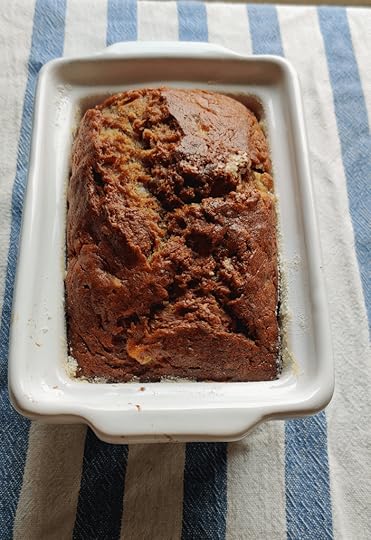
Banana bread might just be the official food of quarantine. At one point in the spring of 2020, I felt like everyone was posting photos of it. The furor died down in 2021 and by this October, I was ready to put those overripe fruit back to work.
This is my version of a popular recipe found online. My shifts include cutting the sugar in half and adding pumpkin pie spice along with a small amount of milk or yogurt to make it a bit more moist. If you want to make it with a blend of bananas and pumpkin, replace one cup of pumpkin for two of the bananas.
You can skip the step of greasing and flouring the pan if you use a silicon baking mold, but watch the baking time closely. I’ve also made this in small aluminum loaf pans to give to friends and family, but lined the bottom of the pan with parchment and coated the sides with butter.
 PrintPumpkin Spice Banana BreadAn easy, inexpensive recipe to use up those bananas that have seen better days. This one doesn't require a mixer, either. Coating the pan is a key step unless you use a silicon baker; I use coconut oil to coat the pan before gently shaking in a little flour to coat the edges. I havesuccessfully made this a couple different types of gluten-free flours. No pumpkin pie spice? See the recipe below. Don't have all the ingredients for the spice mix on hand? Substitute cinnamon or a blend of nutmeg and cinnamon. Makes one loaf, about a dozen slices. Course BakingCuisine AmericanKeyword Autumn, Baking, Bananas, Bread, Easy, Pumpkin Pie, Pumpkin SpiceEquipmentLoaf panIngredients3 or 4 overripe bananas1 ½ cups all-purpose flour1 teaspoon baking soda1 teaspoon baking powder1 teaspoon salt½ cup butter softened2 eggs beaten1 ½ teaspoons pumpkin pie spice1 teaspoon vanilla1 tablespoon milk or plain yogurtInstructionsPreheat oven to 350º F/180ºC. Grease a loaf pan with butter or coconut oil, then coat the sides with flour. Mash the bananas in a bowl. Sift together the flour, baking soda and salt. Set both aside.In a large bowl, mix the softened butter and sugar. Add the eggs, mix again. Then the crushed bananas, spices, vanilla and milk or yogurt and stir well. Add the flour mixture to creamed mixture. Mix just until combined; it should be a bit lumpy.Pour into the prepared pan and bake for about 55 minutes or until cooked through. If you use more than three bananas, use a particularly heavy baking pan or utilize a toaster oven, it may need to bake as long as 1 hour and 10 minutes. Let cool before removing from the pan.Wrap leftovers tightly and stored in the refrigerator for up to five days.NotesYou can make your own pumpkin pie spice by mixing the following together. Store in an airtight jar.3 tablespoons ground cinnamon2 teaspoons ground ginger2 teaspoons nutmeg2 teaspoons cloves1 ½ teaspoons ground allspice
PrintPumpkin Spice Banana BreadAn easy, inexpensive recipe to use up those bananas that have seen better days. This one doesn't require a mixer, either. Coating the pan is a key step unless you use a silicon baker; I use coconut oil to coat the pan before gently shaking in a little flour to coat the edges. I havesuccessfully made this a couple different types of gluten-free flours. No pumpkin pie spice? See the recipe below. Don't have all the ingredients for the spice mix on hand? Substitute cinnamon or a blend of nutmeg and cinnamon. Makes one loaf, about a dozen slices. Course BakingCuisine AmericanKeyword Autumn, Baking, Bananas, Bread, Easy, Pumpkin Pie, Pumpkin SpiceEquipmentLoaf panIngredients3 or 4 overripe bananas1 ½ cups all-purpose flour1 teaspoon baking soda1 teaspoon baking powder1 teaspoon salt½ cup butter softened2 eggs beaten1 ½ teaspoons pumpkin pie spice1 teaspoon vanilla1 tablespoon milk or plain yogurtInstructionsPreheat oven to 350º F/180ºC. Grease a loaf pan with butter or coconut oil, then coat the sides with flour. Mash the bananas in a bowl. Sift together the flour, baking soda and salt. Set both aside.In a large bowl, mix the softened butter and sugar. Add the eggs, mix again. Then the crushed bananas, spices, vanilla and milk or yogurt and stir well. Add the flour mixture to creamed mixture. Mix just until combined; it should be a bit lumpy.Pour into the prepared pan and bake for about 55 minutes or until cooked through. If you use more than three bananas, use a particularly heavy baking pan or utilize a toaster oven, it may need to bake as long as 1 hour and 10 minutes. Let cool before removing from the pan.Wrap leftovers tightly and stored in the refrigerator for up to five days.NotesYou can make your own pumpkin pie spice by mixing the following together. Store in an airtight jar.3 tablespoons ground cinnamon2 teaspoons ground ginger2 teaspoons nutmeg2 teaspoons cloves1 ½ teaspoons ground allspice Photos by Kathleen Flinn. This page may contain affiliate links.
The post Pumpkin Spice Banana Bread appeared first on Kathleen Flinn.
October 17, 2021
Sick of Cooking? Get Thanksgiving To Go
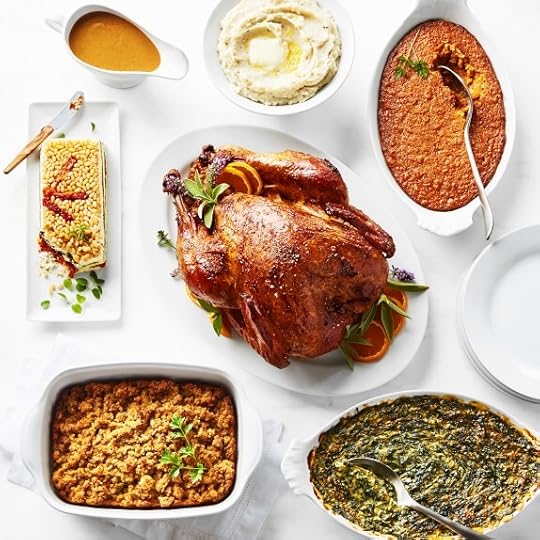 Cajun fried turkey dinner from Williams Sonoma
Cajun fried turkey dinner from Williams SonomaWell, I don’t know about you, but I’d hoped the pandemic would be in the rear mirror by now. Yet, many of us remain separated from family and friends or working from home. The pandemic has forced us all to spend more time in our homes and our kitchens than ever. So if you don’t feel like cooking a big holiday meal, it’s OK. As someone who encourages people to cook, you might expect a different message for me, but give yourself a break. Maybe this is the year to try something different and get Thanksgiving to go. Consider these options.
Support a Local Restaurant Sous vide spatch-cocked turkey from Addo in Seattle
Sous vide spatch-cocked turkey from Addo in SeattleMany eateries that might normally be closed are offering full Thanksgiving meals or meal kits for delivery or pick up this year, often with a twist on their signature cuisine. Inquire directly with some of your favorites to see if there are offering holiday meals or kits, or check out your local eater.com site or food section. Shake things up with a jerked turkey from a Jamaican joint or a smoked turducken from a BBQ spot. While you’re at it, throw some love to local bakeries for pies and other holiday sweets, as well.
Heat and Serve Meals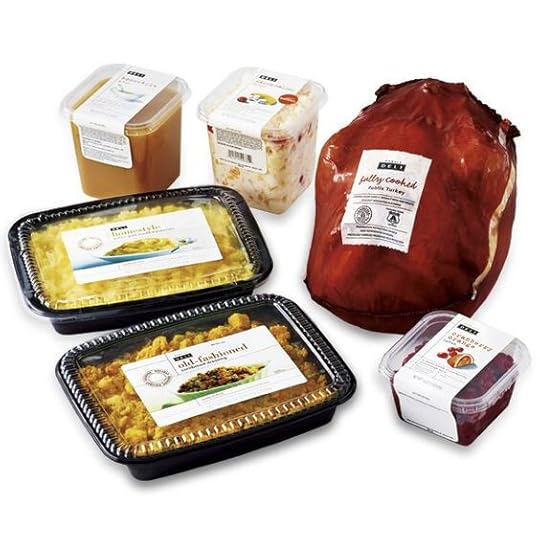 Publix supermarkets Thanksgiving dinner
Publix supermarkets Thanksgiving dinner Many supermarkets offer up heat-and-serve meals. Years ago, I did a comparative tasting on a few for a food client. The sides from large chains tend to be on the bland side. If your budget allows, check out local supermarkets or higher-end markets, too.
Turkeys in these packages tend to be cooked, then frozen, and thus can take hours to reheat, often as long as making a bird from scratch, so allow time for it. These tends to provide good deals ($9 per person and up), and save you time shopping in a busy supermarket during a pandemic. You still have the option of making one or two family favorites to round out the meal.
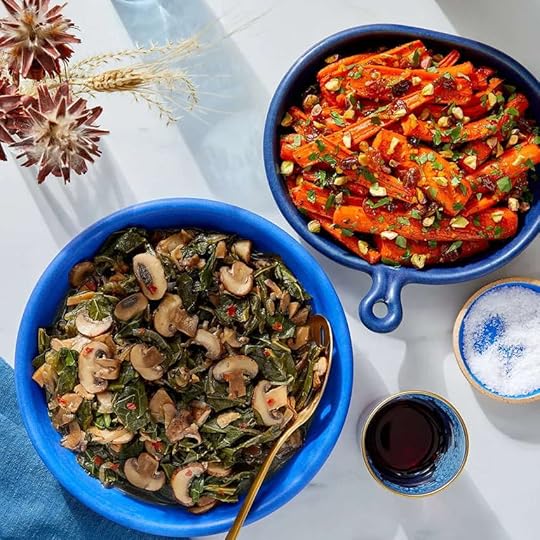 Collards and carrots from Blue Apron’s 2020 Thanksgiving offerings
Collards and carrots from Blue Apron’s 2020 Thanksgiving offeringsA hybrid that allows you the joy of cooking without the non-joy of shopping. Again, check with local restaurants to see if they’ve got a meal kit on offer.
Hello Fresh: Their turkey dinner bundle serves 8 to 10 people, so if you’re a small group, you’ll have a lot of leftovers. If you’re not into turkey, they offer a beef tenderloin dinner for four to six. $16 per person
Home Chef: Customize your meal, as every dish is al a carte. The main protein is a roast turkey breast to serve six, not a whole turkey, but that’s a good thing if you’ve got a small crew. Varies
Blue Apron: This year, Blue Apron partnered up with James Beard award winner Chef Edouardo Jordan from Seattle, who focuses on Southern-focused dishes. His meal serves six to eight and features roasted pork tenderloin anchoring the meal instead of turkey. Sides include cheesy mashed potatoes, braised greens and carrots with a ginger-honey dressing. About $14 per serving.
Purple Carrot: Skip the turkey and go fully plant-based with roasted squash as a savory main, rounded out by fresh takes on traditional sides. After all, yur grandma probably didn’t put kimchi butter in her Brussels sprouts. About $18 per person.
Fancy & Delivered Cranberry stuffing casserole from Williams Sonoma
Cranberry stuffing casserole from Williams SonomaAmazon.com: Well, of course you order a turkey via the world’s biggest retailer. The most highly rated turkey comes from Kansas City-based Burgers Smokehouse which offers fully cooked ready to heat hickory-smoked birds starting at around $79 for an 8- to 10-pound bird and you can buy all the sides and pies to have shipped to you as well. Good option for procrastinators with a Primer membership, or for someone who wants to ship a holiday dinner to a friend or relative long distance.
Williams Sonoma: This upscale kitchen store which will ship you everything from and in full Cajun fried Turkey with all the trimmings. $35 per person and up.
McKenzie Ltd.: Get a complete meal with your choice of a Cajun-style deep fried turkey or stuffed chicken breasts sides. $28 per person and up.
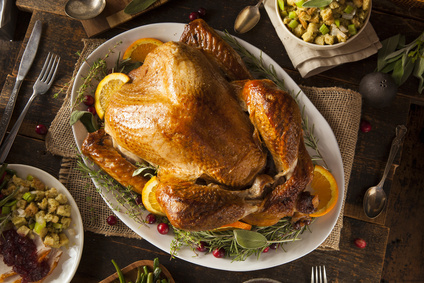 More Thanksgiving coverage
More Thanksgiving coverageHomemade Mashed Potatoes vs. Instant
Homemade Green Beans vs. Canned
Conventional Turkey vs. Organic
19 Ideas for Holiday Leftovers
Note: If you order anything from Amazon.com, I will earn a small commission. I have no affiliation or relationship with any of the other companies.
The post Sick of Cooking? Get Thanksgiving To Go appeared first on Kathleen Flinn.
October 4, 2021
Recipe: White Bean Soup with Greens

don’t know about you, but I’m tired of looking at all those cans of beans that I bought at the start of the pandemic in 2020. I’ve started to realize that some are nearing their sell-by date, too. So, I pulled this recipe from the archives and I’ve made two or three versions in the past couple of weeks. As the weather has turned chillier, it’s been a perfect cooking task when a pot of something on the stove steaming up the windows makes the house feel cozy.
I love this soup as it’s flexible and, since you can start with canned beans, doesn’t take long to prepare, either. It’s a terrific way to use up some of your random greens in your crisper drawer, too. I’ve made variations of this soup with just about every vegetable possible, but I always seem to return to the original combination of white beans and dark greens; they just complement each other somehow.
This is great with some crusty bread (like this no-knead version). If you don’t have stock in your freezer, check out my guide to making chicken stock or vegetable broth. Both work just fine in this recipe.
PrintWhite Bean Soup with GreensA protein-packed healthy, vegetarian stew for cold winter days. Like most soups, this is a flexible way to use up leftover vegetables. Use kale, collard or other hearty greens. But feel free to add in other vegetables. I've used a fistful of leftover green beans sweet potatoes, zucchini. carrots and artichokes.If using cooked vegetables, add them at the end of cooking so they don't overcook. I used canned beans for convenience, but you can obviously include dried beans in their place; just simmer them until soft and then commence with the recipe. To make this properly vegetarian, simply swap vegetable stock for chicken.Course Main CourseCuisine FrenchKeyword beans, budget friendly, greens, kale, soup, vegetarianServings 6Ingredients2 tablespoons oil1 medium onion, chopped
1 carrot, chopped
2 celery stalks, chopped
3 garlic cloves, chopped
2 quarts chicken stock or vegetable stock
1 quart water
1 14 oz. can great northern or cannelloni beans, drained, rinsed
1 14 oz. can chopped and seeded tomatoes, or 2 cups fresh
1 to 2 cups other vegetables
1 tablespoon dried mixed Italian herbs
1/2 teaspoon cayenne
2 cups kale or collard greens, roughly chopped
Salt, ground pepper
Grated Parmesan cheese
InstructionsIn a large pot, heat olive oil over medium heat. Add onion and saute until soft, about three minutes. Add the garlic and cook for another minute. Add the stock, water, beans, tomatoes, vegetables (if raw), herbs, cayenne and pepper and simmer for about 20 minutes. Add greens simmer about 10 minutes. Add soft and pepper to taste. Ladle into bowls; sprinkle with grated Parmesan and a couple grinds of fresh pepper.To make this in an Instant Pot:Heat olive oil in the Instant Pot pan on saute. Add onion and cook untilsoft, about three minutes. Add the garlic and cook for another minute. Add the stock, water, beans, tomatoes, vegetables, herbs, cayenne and pepper and pressure cook for 7 minutes. It can stay on warm for at least an hour. Serrve with grated cheese and fresh pepper.Photo by Nataliya Arzamasova. This post was originally published in February 2009. It has been updated.
The post Recipe: White Bean Soup with Greens appeared first on Kathleen Flinn.
September 8, 2021
How to Make Vinaigrette [video lesson]
Do you have so many bottles of vinaigrette in your fridge that when you open the door it sounds like wind chimes? How to make vinaigrette is one of the first things that any home cook should master for a couple of reasons. It’s expensive to buy and tends to be loaded with artificial ingredients to keep it shelf stable. I did a survey of eight popular brands of “Italian-style” vinaigrette. They averaged 17 ingredients. The basic recipe below has just oil, vinegar, herbs, salt and pepper.
Most people think of vinaigrette as something only to use on green salads. A vinaigrette can also be used as a marinade, splashed on roasted or steamed vegetables or as a light sauce for chicken or seafood.
Three to One – Vinaigrette Ratio1 part acid + 3 parts oil = fabulous stuff
“Acids:” Any kind of vinegar, citrus juices (lemon, lime, grapefruit, etc.)
“Oils:” Fruit & vegetable oils (olive, corn, avocado, etc.), nut oils (hazelnut, walnut, peanut)
In a bowl, add the acid, whisk in the oil. Add salt and pepper to taste. Congratulations, you’ve made vinaigrette. Alternately, and my preferred method, add the ingredients into a jar and shake.
Recipe: French Dijon Vinaigrette1 tablespoon red wine vinegar
3 tablespoons extra virgin olive olive
1 teaspoon finely chopped shallots
1/2 teaspoon Dijon mustard
1 teaspoon chopped fresh thyme or 1/2 teaspoon dried
Two pinches salt
A few grinds fresh coarse pepper
Put the vinegar, mustard and shallots in a small bowl and whisk in the oil. Add the herbs, salt and pepper. Whisk again until incorporated. Taste. Or, you can put all the ingredients into a jar and just shake it vigorously.
Too tart for your taste? Add a bit of olive oil. Not tart enough? Add a couple drops of vinegar. Needs more salt? Add some. Continue until it tastes good to you.
Endless VariationsBut you want a fancy designer gourmet vinaigrette? Raspberry? Blueberry? Then add the berry to the bowl and whisk. Asian vinaigrette? Use some things from the Asian flavor profile: ginger, garlic, miso, sesame oil, peanut oil, soy sauce. An Italian Vinaigrette? Basil, garlic, tomato, white beans. Get some ideas from our “Cheat Sheet” to Profiles
Be creative. Acid and oil don’t like to stay mixed, so if you want, add an emulsifier, like egg yolk, mayonnaise or mustard before adding the oil, drop by drop, while you whisk. Always taste the vinaigrette with a leaf or two of the greens it will be dressing, so you know what it will actually be like on the plate. Some lettuces can suck up the acid tang, others amplify, so taste before serving.
Some examples to get you started:
Three great sherry vinegar-based vinaigrettes by Michael Ruhlman at SimplyRecipes.comWarm bacon vinaigrette by SmittenKitchenSriracha-Balsamic Vinaigrette from BakeYourDayAsian Orange Ginger Vinaigrette from SteamyKitchenA slight variation on Classic French Dijon Vinaigrette with lots of photos by David LebovitzUpdated Oct. 16, 2021.
The post How to Make Vinaigrette [video lesson] appeared first on Kathleen Flinn.
March 11, 2021
Recipe: Easy, Versatile Lentil Soup

I fell in love with lentil soup out of a sense of obligation. On a cold winter day on an early trip to Paris, I stepped inside a small bistro to get out of a frigid winter mist. Why ever did I book a trip to France in January, I wondered? Shivering and cold, all I thought I wanted was a cup of tea. But it was lunchtime and people were eating. I felt compelled to order something to warrant occupying a table. Low on cash, I chose the soup du jour, a casual French green lentil soup studded with bits of smoky bacon.
Ever since, on cold winter days, I yearn for lentil soup. The quality of the lentils does make a difference. While it’s good with the supermarket-variety brown lentils, it takes on a heightened flavor if you use French green or other quality lentils. What’s great about this soup is its inherent versatility. You can make it gluten-free vegan or dose it with bacon, ham or sausage to satisfy a carnivore craving. Use chicken stock or vegetable stock. Want a smokier flavor? Try fire-roasted canned tomatoes. Want it spicier? Twist the flavor with some curry at the end.
 What are lentils?
What are lentils? A lentil is a small, flat, round seed that’s a member of the bean and pulse family known collectively as legumes. Like other legumes, lentils pack a lot of protein and fiber in each bite, but in general, they cook much faster than their bean-y relatives. Americans are generally familiar with just three types of lentils – brown, green and orange – but there’s a whole world beyond that. India grows more than 50 varieties.
Lentils are a great pantry item as they have a long shelf life. They also can be added to recipes such as soups for added protein and fiber, and are a great option if you’re trying to cut down on your meat consumption. My husband loves my mushroom and lentil burgers.
I prefer to use dried lentils over canned lentils. While the latter is convenience, they tend to be packed with sodium.
Dried lentils are sold either with the skin (“seed coat”) as “whole lentils” or with or with the seed coat removed and cut in half, or “split lentils.” Whole lentils are the best choice when you want them to retain their shape for soups, side dishes, salads and so on. “Split lentils,” are best used when you want to cook them into a puree.
 Free lentil cookbook alert!
Free lentil cookbook alert!My husband, Mike, graduated from Washington State University in Pullman, home to an annual National Lentil Festival every August. The state is the largest producer of peas and lentils in the United States, with most grown in the Palouse, the gorgeous rolling hills near Pullman. (Photo above) It’s one of my favorite drives anywhere.
Highlights of the summer festival include a lentil cook-off with the best recipes from cooks all the country collected in a downloadable cookbook. Just flipping through it gave me a newfound respect for the humble lentil. Recipes include Cajun lentil-shrimp hush puppies, caramel Indian-style curry and a red lentil crusted salmon with beluga black lentil caviar potatoes.
-> Get Your Lentil Cookbook Here!
 Cooking Tips
Cooking TipsMost lentil soup recipes make a huge pot. I’m a fan of making smaller pots of soup, hence the recipe below makes about a quart, or four servings. If you’re feeding more, it’s easily double.
Like other legumes, dehydrated lentils expand a lot as they absorb liquid through cooking. Allow about 1/4 cup or 2 ounces (60 g (2 oz) of uncooked lentils per person/serving. Cooking instructions vary depending on the type, so just see the package you’re using for guidance.
However, the following applies to all lentils:
You don’t need to soak dried lentils before cooking, but do rinse them well in a colander and remove any that float. Adding anything acidic, such as vinegar, tomatoes, lemon juice or wine will increase the cooking time slightly. Canned lentils are already cooked, so just rinse before using.Using an Instant Pot is a quick and easy way to make tender lentils. For standard green or brown lentils:
Use a ratio of 1 part lentils to 3 parts waterCook under pressure for about 9 minutesLet pressure naturally release for 15 minutes PrintEasy Lentil SoupThis easy and versatile recipe transforms humble lentils into a hearty, soul-soothing meal. Adapted from Feeding the Whole Family by Cynthia Lair. I've cut the portions down to make about four to six cups, but it is easily doubled. If you don't have vegetable or chicken stock, you can add a couple teaspoons of Better than Bouillion. Feel free to add in chopped potatoes, chopped greens such as kale, chopped zucchini or other remnant vegetables lurking in your fridge. This calls for basic herbs, but you can add 1 teaspoon of curry, smoked paprika, cumin, cajun seasoning or spice it up with red pepper flakes or a whole dried red chili pod. Course SoupCuisine AmericanKeyword budget friendly, Easy, how to use beans, inexpensive, lentils, pantry, soup, VersatileServings 4Ingredients2 tablespoons vegetable oil1 small onion chopped (about 1 cup)1 stalk celery chopped (about 1/2 cup)1 large carrots chopped (about 1/2 cup)2 garlic cloves minced3 cups-plus vegetable broth or chicken stock or water1 cup dried lentils rinsed1 teaspoon thyme mix italian herbs or other seasoning1/2 can diced tomatoes4 oz. cooked ham bacon or sausage in bite-size pieces (optional)Balsamic vinegar optionalHandful fresh chopped herbs optionalInstructionsHeat oil in heavy 2-quart or larger saucepan or pot over medium–high heat. Add onions, celery, carrots, and garlic; sauté until vegetables soften and begin to brown, about 10 minutes. Add the stock or broth, lentils, tomatoes with juice, herbs and bacon or ham (if using). Be sure there's at least an inch of water above the lentils. Bring to boil. Reduce heat to medium–low, cover, and simmer until lentils are tender, adding water or broth as needed. This should take about 30 minutes, or as specified on the package.With a vegetable masher or immersion blender, briefly puree about a quarter of the soup if desired for a creamier texture. Alternately, carefully transfer 1 to 2 cups of the soup to a blender and puree until smooth; be sure to remove the lid and instead cover the hole with a kitchen towel to avoid creating a vacuum in the blender and then return the puree to the pot. Thin the soup as desired with water or broth if you think it’s too thick. Taste and season with salt, pepper and a bit of vinegar and chopped fresh herbs if desired.
PrintEasy Lentil SoupThis easy and versatile recipe transforms humble lentils into a hearty, soul-soothing meal. Adapted from Feeding the Whole Family by Cynthia Lair. I've cut the portions down to make about four to six cups, but it is easily doubled. If you don't have vegetable or chicken stock, you can add a couple teaspoons of Better than Bouillion. Feel free to add in chopped potatoes, chopped greens such as kale, chopped zucchini or other remnant vegetables lurking in your fridge. This calls for basic herbs, but you can add 1 teaspoon of curry, smoked paprika, cumin, cajun seasoning or spice it up with red pepper flakes or a whole dried red chili pod. Course SoupCuisine AmericanKeyword budget friendly, Easy, how to use beans, inexpensive, lentils, pantry, soup, VersatileServings 4Ingredients2 tablespoons vegetable oil1 small onion chopped (about 1 cup)1 stalk celery chopped (about 1/2 cup)1 large carrots chopped (about 1/2 cup)2 garlic cloves minced3 cups-plus vegetable broth or chicken stock or water1 cup dried lentils rinsed1 teaspoon thyme mix italian herbs or other seasoning1/2 can diced tomatoes4 oz. cooked ham bacon or sausage in bite-size pieces (optional)Balsamic vinegar optionalHandful fresh chopped herbs optionalInstructionsHeat oil in heavy 2-quart or larger saucepan or pot over medium–high heat. Add onions, celery, carrots, and garlic; sauté until vegetables soften and begin to brown, about 10 minutes. Add the stock or broth, lentils, tomatoes with juice, herbs and bacon or ham (if using). Be sure there's at least an inch of water above the lentils. Bring to boil. Reduce heat to medium–low, cover, and simmer until lentils are tender, adding water or broth as needed. This should take about 30 minutes, or as specified on the package.With a vegetable masher or immersion blender, briefly puree about a quarter of the soup if desired for a creamier texture. Alternately, carefully transfer 1 to 2 cups of the soup to a blender and puree until smooth; be sure to remove the lid and instead cover the hole with a kitchen towel to avoid creating a vacuum in the blender and then return the puree to the pot. Thin the soup as desired with water or broth if you think it’s too thick. Taste and season with salt, pepper and a bit of vinegar and chopped fresh herbs if desired.NOTE: This post may contain affiliate links. Originally published in 2016, updated in 2021. Finished soup image by Nina Firsova. Lentil types illustration by Everlida. Palouse image provided by ScenicWa.com. Generic lentil image from Pulses USA. I received no compensation from the lentil folks for this one; I just like them. 
The post Recipe: Easy, Versatile Lentil Soup appeared first on Kathleen Flinn.
March 2, 2021
Recipe: Spicy Turkish Chicken Wings with Chili-Oregano Salt
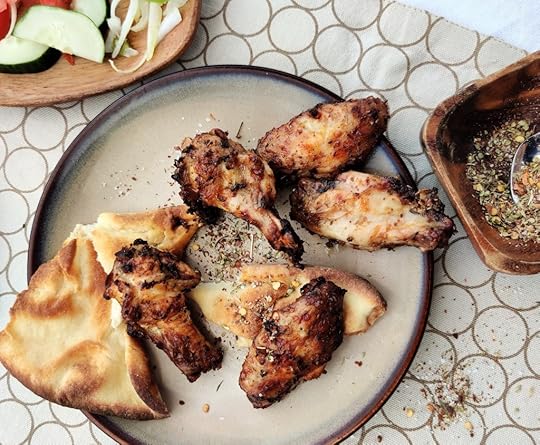
This recipe was developed by food journalist Robyn Eckhardt for the remarkable book Instanbul and Beyond: Exploring the Diverse Cuisines of Turkey. We ate them as part of the conversation we had for my podcast, Hungry for Words. You can listen here.
This is her version of the not-too-spicy savory chicken wings found on huge rotisseries throughout Istanbul’s famed Tahtakale Market, Istanbul’s famed spice bazaar. Even a modest stalls may sell hundreds of pounds of wings a day. She notes the wings are generally accompanied by a few traditional sides: grilled green chiles, sliced onions and tomatoes along with a bulgur pilaf and dimpled flatbreads. The wings are first tenderized in a bath of vinegar and onion, then coated in a seasoned olive oil. Having made these several times now, there are two keys: the vinegar/onion marinade and the accompanying salt.
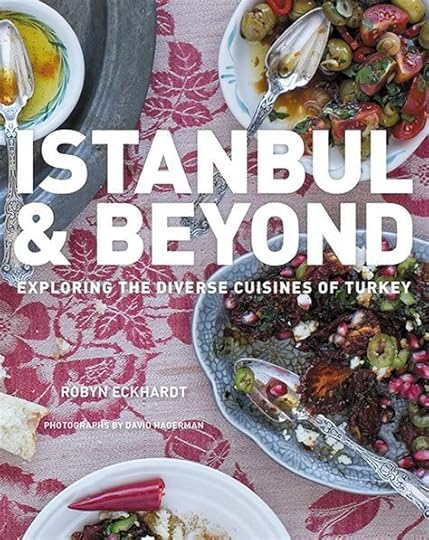
Click the cover to listen to my chat with Robyn
The recipe calls for Aleppo chili pepper which can be tricky to find. I get mine from World Spice in Seattle. You can substitute red pepper flakes. I prefer using oregano to thyme or a blend of the two in this recipe.
She recommends against barbecuing these and I agree; a hot oven will best mimic the rotisserie flavor. These are best cooked on a large cooking sheet fitted with a cooling rack. If you don’t have one, a broiler pan works fine. Neither? A plain cookie sheet works, just turn them regularly while cooking. I admit, we usually just eat the wings alone, but you can make a meat of them if you serve with some flatbread, a savory grain and sliced onions, tomatoes and cucumber. They reheat fabulously.
PrintTurkish Market Chicken Wings with Chili-Thyme SaltAddictive spicy and savory wings from Istanbul's famed spice market.Course AppetizerCuisine MediterraneanKeyword chicken, Easy, picnic fare, spicy, take to a party, Turkish, wingsServings 4Author Robyn EckhardtEquipmentTongsBaking sheetCooling rackIngredientsTenderizing marinade16 chicken wings (about 2 lbs/1 kilo)1 medium onion1 cup apple cider1 teaspoon sea saltSeasoning marinade3 tablespoons olive oil1 teaspoon Aleppo pepper or dried red pepper flakes3/4 teaspoon ground cumin1 teaspoon dried thyme or oregano½ teaspoon sea saltHerb-Chili Salt1 tablespoon dried thyme or oregano 1 tablespoon Aleppo pepper or red pepper flakes½ teaspoon coarse saltInstructionsTenderizing marinadeGratethe onion or pulse in a food processor. In a large bowl, combine with thevinegar and salt and stir to combine. Add the wings and toss to coat. Cover thebowl and marinate overnight or for at least four hours, jostling the wings fromtime to time. To save space in your fridge, you can transfer to a well-sealedplastic bag. Seasoning marinadeCombinethe olive oil, chili flakes, cumin, thyme or oregano and sea salt in a largebowl. Remove the wings from the tenderizing marinade, pat dry with paper towelsand add to the bowl. Stir or toss with tongs until the wings are coated withthe new marinade. Cover and refrigerate for at least an hour or up to fourhours. Herb-Chili SaltIna small bowl, mix the red pepper and the thyme or oregano. Stir in the salt.Set aside.Roast the wingsPreheat the oven to 450*F/TKC. Line a baking sheet with foiland top with a oiled cooling rack, or line a broiler pan with foil. Remove thewings from the marinade and roast for about 10 minutes. Using tongs, turn andcook an additional 10 to 15 minutes until well browned and cook through. Servehot with the chile-herb salt.The post Recipe: Spicy Turkish Chicken Wings with Chili-Oregano Salt appeared first on Kathleen Flinn.



